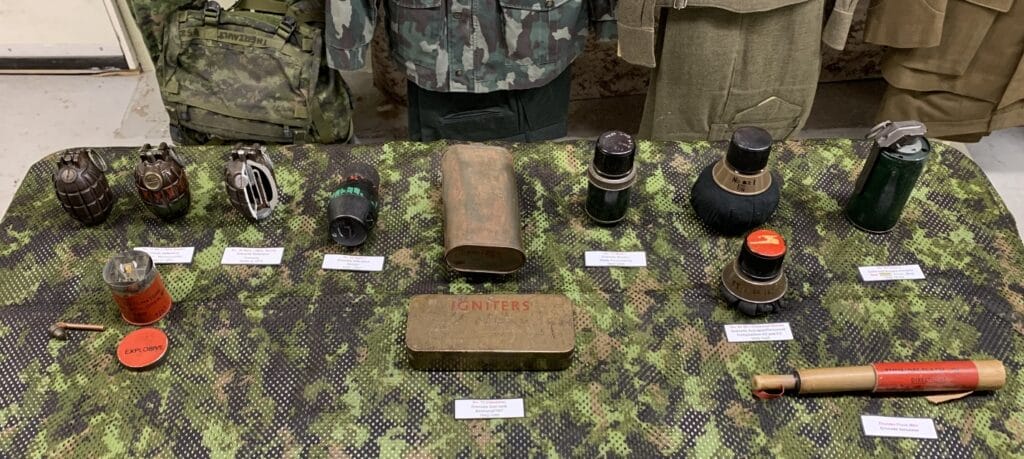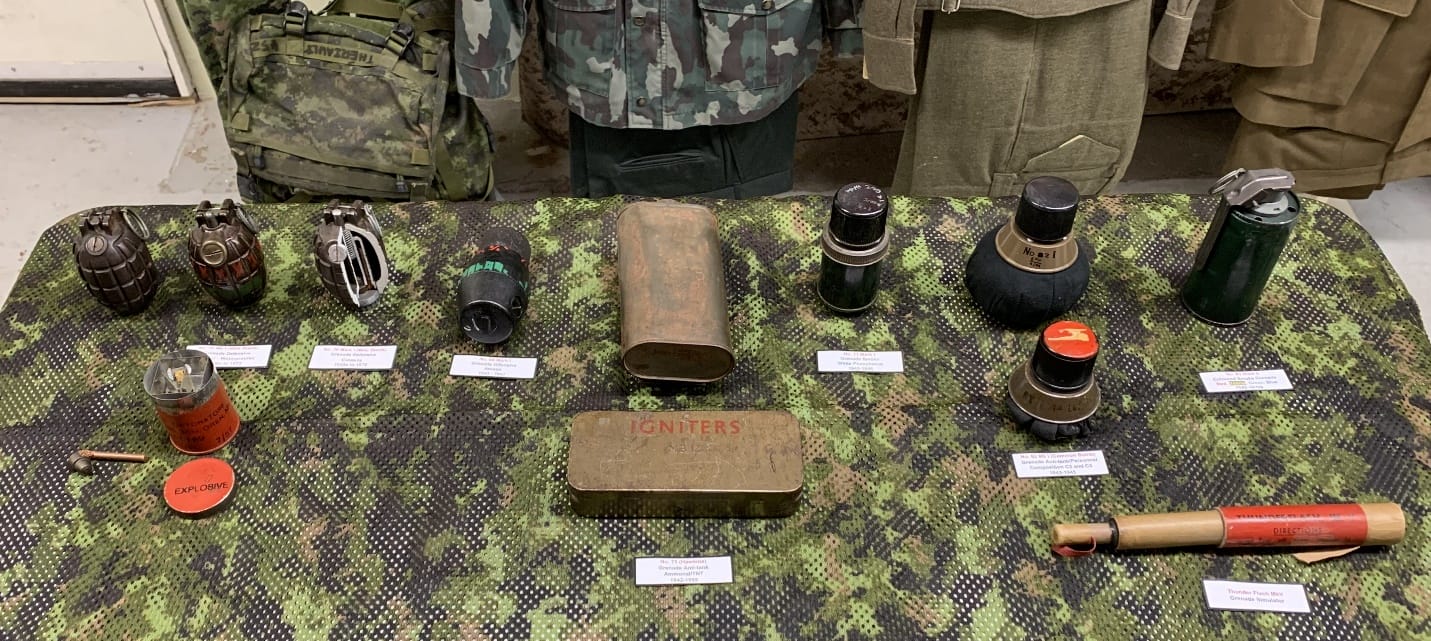WWII BRITISH GRENADES
This week’s exhibit at our “micro” museum located at “SEBARMS Guns, Gear and Collectibles” focused on the commonly used grenades used by British Commonwealth troops during the Second World War.
Today, Claude Villeneuve of Valor Park Association (VPA) brought four types of grenades that were used by the British Airborne Forces, including 1st Canadian Parachute Battalion, during the Second World War. With exception of the filled “Gammon Bomb” every item was original.

TYPES OF GRENADES
Grenades are small bombs suitable for throwing by hand or for firing from a rifle or from a projector. They may contain high explosives for anti-personnel or anti-tank use, or for demolition purposes; smoke-producing materials for screening purposes; signal or illuminating compositions; incendiary compositions; or chemicals.
The grenades used by the British during the Second World War were classified as follows:
- Anti-personnel: № 36M, № 69,
- Anti-tank: № 68, № 73, № 74, № 75, № 76, № 82,
- Smoke, screening: № 63, № 77, № 79, № 80, № 81,
- Smoke, signalling: № 83; and
- Flare, Signal and Illuminating: № 57, № 58, № 59, № 60, № 61, № 62.
GRENADES, ANTI-PERSONNEL H.E.
Anti-personnel effect can be achieved with high explosives (H.E.) grenades in two ways: by fragments (defensive) or by blast (offensive).
Grenade, Hand, № 5 Mk I (Mills Bomb). Considerate a “defensive” grenade, this fragmentation grenade was an improvement by Sir William Mills in 1915 of the “Roland Grenade” patented in 1912 by Captain Leon Roland of the Belgian Army. It became the standard anti-personnel hand grenade until the end of the First World War and was declared obsolete on 6 May 1920. Filling may be Ammonal, Amatol 80/20, Sabulite, Baratol, or Cilferite. Before use, the grenade needed to be primed with a detonator assembly. The fuze delay was 5 seconds. Throwing range was about 30 yd (27 m) with a danger area of about 100 yd (91 m). They were packed 12 in Box G36, with 12 igniter sets Mk V or VII in a tin and one base plug key. Grenade, Hand, № 5 was replaced by the № 23 which will be replaced by the № 36.
Grenade, Hand, № 36 Mk I (Mills Bomb). The Grenade № 36 Mk 1, considered a “defensive” grenade, was first introduced in May 1918, and was declared obsolete on 5 December 1932. Made of cast iron, it weighed 1.5 lb. It was drilled and threaded for attaching a metal disk called a gas check to fire the grenade from a cup discharger (Burns) mounted on a rifle’s muzzle and launched using a ballistite cartridge. Filling may be either Ammonal, Alumatol, Amatol 80/20, Cilferite “C”, or Amatol 83/17. Having four Mks of igniter set, the fuze delay varied between 4 seconds when throw by hand (Mk V and VII) or 7 seconds when fired from a rifle or projector (Mk II and III). Throwing range and danger area are like the № 5. The shellac-coated “Mesopotamian” variant (№ 36M Mk I) was designed to keep moisture and humidity out of the detonator’s fuse. The № 36M Mk I was the British army’s standard hand-grenade from the 1930s to 1972. Hand grenades were packed 12 in Box G36, with 12 igniter sets Mk V or VII in a tin and one base plug key.
Identification marks.
- Green band: around the middle originally indicated an Amatol filling (1915–1920s), while it later indicated a Baratol or Trotyl filling (1920s–1970s).
- Pink band: around the middle indicates an Ammonal or Alumatol filling.
- Red band: around the base plug on the bottom indicated the detonator was already installed and that the grenade was live.
Red “X”: along each side indicates that it is the waterproofed № 36M model.
Grenade, Hand, № 69 Mk I. Considerate a “offensive” grenade, relying on blast for its effects. This grenade was introduced in December 1940 and declared obsolete by 1947. It was made from the then relatively new material “Bakelite” (now known as a thermo-setting plastic). Filling may be Picric Acid, Lyditte, Amatol 80/20, or Baratol 20/80. The grenade was equipped with a № 247 Always Fuze Mk I which was designed to operate when thrown in any position. The fuze delay was 7 seconds (arming tape of 11½ inch). The flash produced by the percussion cap initiates the detonator or priming composition, which in turn detonates the H.E. filling of the grenade. The grenade was supplied with Detonator № 46 Mk I as a separate component assembled prior to throwing. The transit/safety cap was retained in position by a piece of adhesive tape. Grenades were packed 34 in Box B167 with two wooden cylinders with tinned plate lids each containing 17 detonators.
Attempts in 1944 to convert the grenade into a defensive grenade by adding a fragmentation sleeve proved unsuccessful as they were inferior to the H.E. grenades then in use.
Grenade, Hand, № 82 Mk I (Gammon Bomb). The grenade was introduced for service in May 1943 and declared obsolete by 1945. Designed by Capt. R. S. Gammon of the 1st Battalion, The Parachute Regiment, the grenade was formerly known as the “Gammon Bomb”. The grenade was especially suitable for the destruction of parked aircraft or vehicles. The body was a stockinette bag, the top of which was clamped between the tinplate fuze housing and the steel cup by rivets. The bag was gathered at its base by an elastic band to assist in holding the charge of Plastic Explosive (P.E.) when this was inserted. In its anti-personnel use, nails, stones and etc. could be inserted. The grenade was issued with the bag empty, and the charge of P.E. was inserted through the bottom of the bag after the grenade was primed with Detonator № 78 Mk I. The grenade was fuzed with the № 247 “Always” fuze Mk III which had a 4 ½ inch tape for rapid arming. The top of the safety cap was painted red to indicate this fact. Grenades were packed 40 in a steel Box G70 with 40 detonators, № 78 Mk I in four tins. The P.E. was packed separately.
GRENADES, ANTI-TANK
The primary object of the anti-tank grenades is to stop armoured fighting vehicles by breaking their tracks and damaging their suspension.
Grenade, Hand, № 75, Anti-Tank Mk I and II (Hawkins). The Mk I was introduced for service in June 1942 and was declared obsolete by March 1946. The Mk II introduced for service in June 1943 and was declared obsolete by July 1955. This is really an anti-tank mine filled with H.E. and is normally used as such, though it can also be thrown under the track of a tank. The grenade was exploded by the weight of the vehicle passing over it and “crushing” two chemical Igniter assemblies consisting of Detonator № 83 Mk I with Detonator № 27 Mk I cemented on. Having a 1-pint capacity, filling for the Mk II could be either Nobel’s Explosive № 704B plus four exploders, Burrowite plus four exploders, or Burrowite and Nobel’s Explosive № 704B. Details of filling are stencilled on the base of the grenade. Grenades were packed 12 in a steel Box G70. 24 igniters and 24 detonators were packed in two separate containers marked “DETONATORS” and “IGNITERS” respectively and were stowed at one end of the box behind a steel packing shield.
Identification marks.
- Red band: around the neck the screw cap indicated exploders used contained Nobel’s Victor powder or Nobel’s Explosive № 673.
- Red “X”: around the neck the screw cap indicated exploders used contained Polar Dynamite.
- Pink screw cap: filled with Burrowite.
- Pink screw cap with “A” marked on body: filled with Ammonal.
GRENADES, ANTI-TANK
Smoke grenades are used either for local obscuration or for signalling. For screening purposes, both the bursting type and the emission type are employed. For signalling purposes, coloured smoke has been introduced.
Grenade, Hand, № 77, Smoke, W.P. Mk I and Mk II. The object of this grenade is to produce an immediate local smoke screen. The Mk I was introduced for service in February 1943 and was declared obsolete by March 1948. Interestingly, the Mk II (originally designate № 93) was introduced for service in January 1943 and was declared obsolete by January 1946. The Mk II was used exclusively for training. The grenade was equipped with a № 247 Always Fuze Mk I. The grenade needed to be primed with Detonator № 63 Mk I and was filled with approximatively 8 oz of white phosphorous. The grenades were packed in a steel box B166, in 9 cardboard containers, one of which carried two grenades and two cylinders, each containing 17 detonators. In the later and more widely used packing each packing piece has an extra hole, ringed with red paint, for a cylinder carrying 17 detonators.
In the later and more widely used packing 34 grenades are carried in a steel box, B166, 17 in each of two cardboard packing pieces. Each packing piece had an extra hole, ringed with red paint, for a cylinder carrying 17 detonators.
№ 63.
Grenade, Hand, № 83, Mk II Smoke. This was a coloured smoke grenade used for signalling purposes, such as to indicate positions of own troops in daylight and was intended to replace the № 26 smoke generator. The Mk I was introduced for service in February 1944 and was declared obsolete by March 1948. The grenade was equipped with a Striker Mechanisms № 3 which will hit an Igniter №, 83 Grenade consisting of a cap holder with a rimfire cap crimped onto a length of Fuze, Instantaneous burning, Mk IV which will ignite the primed fabric. Smoke emission was between 20 to 40 seconds. There were four types of smoke colours:
- Red: Composition P.N. 469A,
- Yellow: Composition P.N. 473A,
- Green: Composition P.N. 468A, P.N. 490A, OR P.N. 491A, and
- Blue: Composition P.N. 471A, P.N. 510, OR P.N. 603.
GRENADES, ANTI-TANK
Thunderflash Mk V. This was used to simulate exploding grenades and battle noises. It contained an explosive charge which could cause injury when improperly used.
Here is the list of items that were displayed.
There will be more to see from our Quartermaster so…come to see us! The VPA’s “micro” Museum is located at SEBARMS Guns, Gear and Collectibles, 11569 – 149 Street, Edmonton, Alberta, T5M 1W9.
The museum’s hours of operation are:
- Tuesday: from 10 to 15 hours.
- Wednesday: from 10 to 15 hours.
- Thursday: from 10 to 15 hours.
- Friday: from 10 to 15 hours.
Until next time,
The Quartermaster

